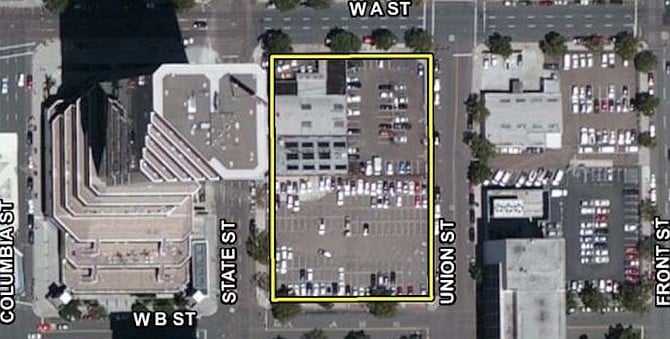 Facebook
Facebook
 X
X
 Instagram
Instagram
 TikTok
TikTok
 Youtube
Youtube

It's been more than five years since transportation officials came up with a plan to get buses and portable toilets off certain city streets. The downtown bus stopover project evolved to add a new headquarters and multiuse development as well.
The San Diego Association of Governments (SANDAG) is developing the project in partnership with the Metropolitan Transit System, which has now awarded another $1.4 million in funding. But the board still hasn't decided which option to pursue.
Today, the multimillion dollar plan is just a bus stop.
San Marcos mayor, Rebecca Jones, a board member, said there has been no discussion of whether it was still planned as a headquarters for SANDAG.
A stopover, the most basic plan considered, includes a parking lot and restroom that will prevent 400 buses from having to idle along parking-poor streets between routes and keep bus drivers from having to hunt for a portable toilet.
"Right now it's envisioned to be a bus stop, because the buses right now are parking in the streets, both the Rapid and the local," said Hasan Ikhrata, the agency's executive director, at a Dec. 17 board meeting.
The number of bus routes that end in downtown is expected to surge with the growth of the region’s Rapid network, and the lot is expected to serve over 700 buses.
The project would take over a privately owned block in the Columbia neighborhood, bounded by A Street, Union Street, B Street and State Street.
Criticism of the proposal has focused partly on its cost - approximately $46 million allocated from TransNet, the voter-approved half-cent sales tax for transportation projects administered by SANDAG. Then there's the proposal to use eminent domain, forcing five different property owners to sell their land.
By June, 2018, the agency had two willing sellers and is currently in the process of acquiring the other properties, which the additional $1.4 million will be used for.
One of the willing sellers was GLP Trust & Stahlman Family Properties LLC (the Stahlman offer and appraisal value was $8,650,000). A previous holdout, the San Diego County Bar Association, has apparently agreed to sell
Acquiring land through eminent domain requires that the project serves the public interest and is necessary.
According to the agency, several sites were studied before they settled on the city's civic core in 2016 as the most suitable to ensure on-time transit for downtown riders. "The current and future need for housing buses at the stopover facility requires the acquisition of the entire city block."
The stopover will increase on-street parking since buses will no longer have to park in front of homes and businesses while awaiting their next route.
The transportation agencies hope to have the lot open for use in 2023. Ikhrata agreed to provide more information at an upcoming meeting, including the amount of regional dollars spent so far.


It's been more than five years since transportation officials came up with a plan to get buses and portable toilets off certain city streets. The downtown bus stopover project evolved to add a new headquarters and multiuse development as well.
The San Diego Association of Governments (SANDAG) is developing the project in partnership with the Metropolitan Transit System, which has now awarded another $1.4 million in funding. But the board still hasn't decided which option to pursue.
Today, the multimillion dollar plan is just a bus stop.
San Marcos mayor, Rebecca Jones, a board member, said there has been no discussion of whether it was still planned as a headquarters for SANDAG.
A stopover, the most basic plan considered, includes a parking lot and restroom that will prevent 400 buses from having to idle along parking-poor streets between routes and keep bus drivers from having to hunt for a portable toilet.
"Right now it's envisioned to be a bus stop, because the buses right now are parking in the streets, both the Rapid and the local," said Hasan Ikhrata, the agency's executive director, at a Dec. 17 board meeting.
The number of bus routes that end in downtown is expected to surge with the growth of the region’s Rapid network, and the lot is expected to serve over 700 buses.
The project would take over a privately owned block in the Columbia neighborhood, bounded by A Street, Union Street, B Street and State Street.
Criticism of the proposal has focused partly on its cost - approximately $46 million allocated from TransNet, the voter-approved half-cent sales tax for transportation projects administered by SANDAG. Then there's the proposal to use eminent domain, forcing five different property owners to sell their land.
By June, 2018, the agency had two willing sellers and is currently in the process of acquiring the other properties, which the additional $1.4 million will be used for.
One of the willing sellers was GLP Trust & Stahlman Family Properties LLC (the Stahlman offer and appraisal value was $8,650,000). A previous holdout, the San Diego County Bar Association, has apparently agreed to sell
Acquiring land through eminent domain requires that the project serves the public interest and is necessary.
According to the agency, several sites were studied before they settled on the city's civic core in 2016 as the most suitable to ensure on-time transit for downtown riders. "The current and future need for housing buses at the stopover facility requires the acquisition of the entire city block."
The stopover will increase on-street parking since buses will no longer have to park in front of homes and businesses while awaiting their next route.
The transportation agencies hope to have the lot open for use in 2023. Ikhrata agreed to provide more information at an upcoming meeting, including the amount of regional dollars spent so far.
Comments